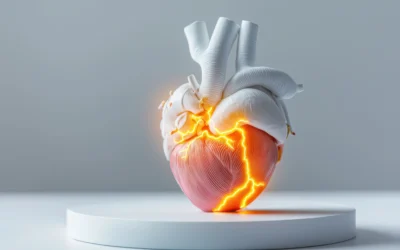Vasovagal syncope, also known as neurocardiogenic syncope or simply “fainting,” is a common disorder characterized by a sudden loss of consciousness and muscle tone, typically followed by a rapid recovery. This condition occurs when the body reacts to certain triggers by initiating an exaggerated response of the vagus nerve, a crucial part of the autonomic nervous system. The result is a drop in heart rate and blood pressure, leading to reduced blood flow to the brain and temporary loss of consciousness.
Symptoms
The main symptom of vasovagal syncope is fainting, but there are often warning signs that precede it. These may include:
- Lightheadedness or dizziness
- Feeling hot or sweaty
- Nausea
- Blurred or narrowed vision (tunnel vision)
- Paleness
- Weakness
- Feeling unsteady
Fainting usually lasts only a few seconds to a few minutes, and the person typically recovers quickly once they lie down or sit up. Occasionally, a person may experience some confusion upon regaining consciousness.
Causes
Vasovagal syncope occurs due to a malfunction in the body’s autonomic nervous system, which controls involuntary functions like heart rate, blood pressure, and digestion. This malfunction causes an exaggerated response to certain triggers, leading to a sudden drop in heart rate and blood pressure. Common triggers for vasovagal syncope include:
- Prolonged standing
- Sudden changes in posture, like standing up quickly
- Dehydration
- Overheating or being in a hot environment
- Emotional stress or shock
- Seeing blood or experiencing pain
- Straining during bowel movements
- Physical exertion
Risk Factors
While vasovagal syncope can affect anyone, some factors may increase the risk:
- Age: Vasovagal syncope is more common in adolescents and young adults, although it can occur at any age.
- Family history: A genetic predisposition may exist for vasovagal syncope.
- Certain medical conditions: Disorders affecting the autonomic nervous system, such as Parkinson’s disease, can increase the risk.
Prevention
To reduce the risk of vasovagal syncope, consider the following strategies:
- Stay hydrated: Drink plenty of water, especially in hot weather or when exercising.
- Avoid triggers: If you’re aware of specific triggers, try to avoid them.
- Change positions slowly: Gradually move from lying down to sitting and from sitting to standing.
- Wear compression stockings: These can help improve blood flow and reduce the risk of fainting.
- Flex your muscles: Tensing your leg muscles when you feel lightheaded can help increase blood pressure and prevent fainting.
When to See a Doctor
While vasovagal syncope is usually harmless, it’s essential to consult a healthcare provider if you experience recurrent fainting episodes, faint without a clear trigger, or hurt yourself during a fainting spell. Additionally, seek medical help if you have a family history of heart disease or sudden death, as fainting may indicate an underlying heart condition.
Diagnosis of Vasovagal Syncope
Diagnosing vasovagal syncope usually involves a thorough medical history and physical examination. Your doctor will ask about the circumstances surrounding your fainting episodes and any accompanying symptoms. To rule out other potential causes of fainting, such as heart problems or other neurological conditions, your doctor may order several tests, including:
- Electrocardiogram (ECG): This test measures the electrical activity of your heart to identify any irregularities in your heart rhythm or structure.
- Echocardiogram: This test uses ultrasound to create detailed images of your heart, helping your doctor to identify any structural heart problems.
- Holter monitor: This portable ECG device is worn for 24 to 48 hours to record your heart’s electrical activity as you go about your daily activities. It can help identify irregular heart rhythms that may lead to fainting.
- Tilt-table test: If your fainting triggers are not clear, your doctor might recommend a tilt-table test. During this test, you lie on a table that tilts to simulate the process of standing up by forcing blood from your upper body to your legs. Abnormal blood pressure and heart rate changes can indicate vasovagal syncope.
Treatment Options for Vasovagal Syncope
Most people with vasovagal syncope don’t require medical treatment. However, if you’re prone to recurrent episodes, your doctor might recommend the following treatments:
- Lifestyle changes: Avoiding known triggers, staying hydrated, and getting up slowly from a lying or seated position can help prevent fainting episodes.
- Physical counterpressure maneuvers: These techniques involve tensing your muscles to raise your blood pressure when you feel like you might faint. Your doctor can teach you specific maneuvers.
- Medications: In some cases, medications like beta-blockers, fludrocortisone, or selective serotonin reuptake inhibitors (SSRIs) may be prescribed to help prevent fainting.
- Pacemaker: Rarely, if fainting is frequent and severely affects your quality of life, your doctor may recommend a pacemaker, especially if you have certain heart rate abnormalities.
Complications of Vasovagal Syncope
While vasovagal syncope itself isn’t typically dangerous, the risk of injury from falling can be a concern. People who experience fainting episodes might be at risk for:
- Injuries from falls, such as fractures or head injuries.
- Accidents while driving or operating heavy machinery.
If you experience vasovagal syncope while driving, you should discuss this with your doctor. They may have recommendations for managing your condition and any necessary precautions.
In conclusion, Vasovagal syncope is a common condition characterized by a temporary loss of consciousness due to a sudden drop in heart rate and blood pressure. Recognizing the symptoms and triggers can help prevent fainting episodes and minimize the risk of injury. If you experience recurrent fainting or have concerns about your health, consult a healthcare provider for a proper evaluation and appropriate management.









